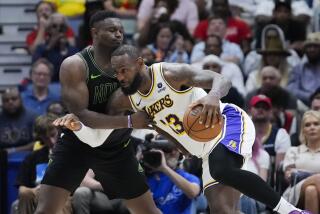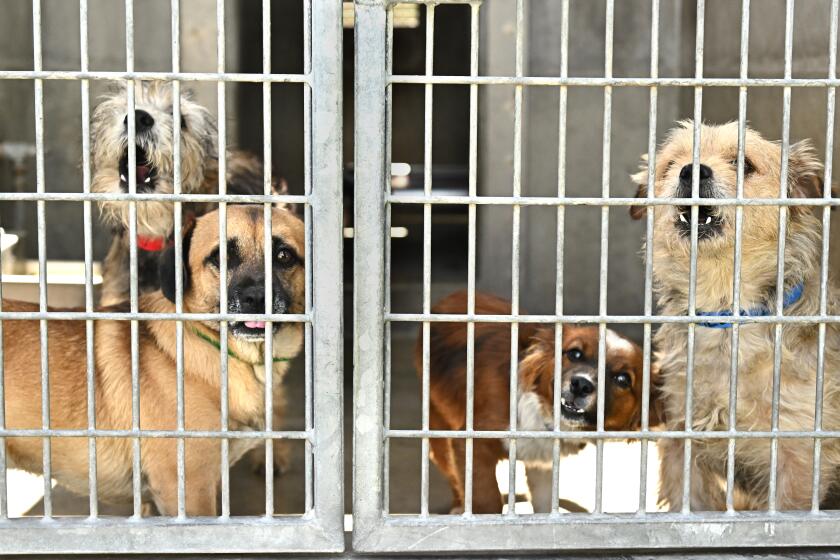Hold on, cowboys
Under the hot lights and cheering crowds at the Orleans Casino Arena, rancher Don Kish, a solidly built man with the rosy skin of good health and good humor, shoves back his cowboy hat and, shoulder-to-shoulder with half a dozen other cowboys, leans over the top rail of the chute. Sweat beads on Kish’s nose while he tightens the nylon flank rope on his orneriest young bucking bull, a Brahma cross named Smooth Move.
It’s the final day of the first-ever Bucking Bull Classic, the biggest-ever rodeo venue for young bulls, and Smooth Move isn’t just Kish’s baby -- born and raised on his Northern California farm -- he’s Kish’s best shot at winning $100,000. Professional bull rider Tater Porter, a tall drink of water out of Kenansville, Fla., straddles Smooth Move’s nervous back, ready to rumble. And Kish has an awful lot depending on how the ride turns out.
Smooth Move is only 3 1/2 -- bulls typically don’t enter the big-time rodeos until 5 -- and he’s never been mounted by a veteran like Porter, or by anybody at all who might stay on his back for the eight seconds that constitute a complete bull ride. So anything could happen. If Smooth Move gives Porter a truly wild ride, or even plants him in the dirt in front of this feverish crowd of bull breeders, bull riders, investors and fans, Kish might go home this late October day with a fat wallet and an animal that everyone will watch for years to come. But Porter’s a strong man with a history on strong bulls, and if he dominates Smooth Move -- pulling a lot of rope and gripping like iron with his long legs -- the bull might get so discouraged it’ll just give up, setting its career back.
A flank rope runs under a bull’s belly, in front of its hind legs -- although not, as some think, around the genitals -- and it agitates the animal in a way that incites him to kick like crazy. Every bull needs the rope set differently, and only Kish knows Smooth Move well enough to get it right. Too loose, and the bull might not kick; too tight, and those kicks might not thrust hard. With certain bulls, the flank rope also lets a bull contractor like Kish play a chess game with the rider. He can see which hand the guy holds on with and tweak the rope so the bull will spin the opposite direction.
It used to be that bull riding was just something cowboys did on their days off, but the sport has so grown in popularity that across town on this same weekend the Professional Bull Riders World Finals of the Built Ford Tough Series were being broadcast on NBC, the Outdoor Life Network and Telemundo. As a result, the bull breeding business is starting to look more and more like the thoroughbred racehorse industry, although with a difference: All the ag-school breeding tricks and fancy training focus not just on speed and power but on the sheer competitive urge to chuck cowboys out of an arena.
Which is why Tater Porter, tightening a second rope around his left hand -- this one is known as the bull rope, and it’s the one Porter will hang onto -- is doing his darndest not to touch Smooth Move with his spurs. Smooth Move is an especially “rank” or “juicy” bull, and so new to the rodeo scene that the bright lights and loud rock ‘n’ roll ought to be scaring the heck out of him. He could easily start bucking while still in the chute. Another bull did this very thing earlier in the day and smashed its rider against a gate, splitting the man’s head open.
Two more cowboys, known as bullfighters and dressed in American-flag shirts and torn shorts, crouch nearby in the dirt, ready to intervene if Smooth Move tries to trample or hook Porter after bucking him off. Then Porter nods his narrow chin, the sign he’s ready for eight seconds of mayhem aboard an enraged 1,500-pound animal with horns. Yet another cowboy flings open the metal gate, Smooth Move explodes into the open, and the game is on.
In simpler times, rodeo organizers dragged mean animals out of feed lots and sale yards, talked gullible cowboys into climbing on, and then watched what happened. This approach worked especially well down in Oklahoma and Texas, where cattle roamed so much range that they were mostly mixed-blood maverick breeds, full of the wildness that makes bulls buck. But by the time Kish got into the business in the early 1980s, California ranchers had bred all the buck out of their cattle, concentrating on high-end dairy and beef breeds. The only breeder of bucking stock in the state had died, and only three of his animals were known to be living. When Kish contacted the owner of one, he learned the bull had just been canned, or slaughtered for meat, and when he tried to buy the second, the owner abruptly bailed on the deal. “So it came down to basically one animal,” Kish says.
He succeeded in buying that bull -- his name was Fonzie, and Smooth Move is a descendant -- but buying Fonzie was the easy part. Sure, Kish got a crop of calves, but it took five years to find out if any were great bucking bulls, and then another five to discover if the best bulls had sired good calves. When Kish finally had his answer, Fonzie had died and his sons were old. But Kish persevered at his ranch outside Red Bluff, and by the early 1990s he and his wife, Janelle, were well-established names in the rodeo business.
Then in 1992, a group of rodeo cowboys formed the Professional Bull Riders, dedicated to staging the sport separately from multi-event rodeos and positioning bull riders as extraordinary athletes who can earn seven figures a year. Several years ago, the organization decided to also market great bulls, arguing that every eight-second ride demands two great athletes. Its strategy plays out in spectacles like the million-dollar match-up last year that saw PBR rider Chris Shivers housed at the Doubletree, outside Colorado Springs, and his opponent, a three-time Bull of the Year named Little Yellow Jacket, rooming at the upscale Broadmoor hotel, in a special tent with a chandelier and a bed of grass.
“That was very important because we started humanizing the animal, which gives people respect for them,” says Randy Bernard, CEO of PBR. “Most of these animals, they’re 2,000 pounds of wanting to hurt these guys, but now they’re looked upon as these cuddly little things.”
Partly as a result of this shift, a spin-off rodeo circuit sprang up to show off and season 2-, 3- and 4-year-old bulls. Once Smooth Move favorably impresses the PBR brass at this level and turns 5, Kish can enter the elite events that pay all kinds of cash bonuses and also put bulls on breeders’ radars.
With Little Yellow Jacket earning about $100,000 a year off semen alone, the bull-breeding business is attracting loads of newcomers. Robbie Herrington, a Texas businessman, made himself a major player overnight in 2000, spending $250,000 on four famous bulls and starting a breeding and training program.
A market has also emerged for shares of promising bulls. “I have an attorney in L.A.,” says Lynn Rice, a breeder from Oklahoma, “and he’s just interested in this sport, wants to see that bull, so a guy like me trains the bull, hauls him to these events, bucks him under the attorney’s name, and he has pictures of his bull in his office, and trophies, just like the racehorse deal. And if that bull does well, he gets his share of it.”
Kish bred Smooth Move the way he breeds all his bulls: by putting a good sire in a pasture with 20 good cows and hoping for the best offspring his bloodlines can deliver. But more and more breeders use embryo transfer technology: artificially inseminating a cow, flushing the fertilized embryos, and then implanting those embryos in surrogates to carry, birth and milk the calves. Cloning has also produced calves, but they are still too young to know if they buck.
Kish is also a traditionalist in the way he has trained -- or, more accurately, not trained -- Smooth Move. Bucking ability is genetic, and Kish’s only active contribution is spending 40 weekends a year on the road at high school rodeos and professional multi-event rodeos and PBR events, so his bulls get a lot of practice and stay fit. But here too other breeders are experimenting with things like dummy cowboys that eject on electronic command from a remote control. And more than a few bulls regularly visit the chiropractor, according to breeder Rice, where rubber mallets are used to adjust their vertebrae.
To track the bull gene pool, the PBR and some breeders, including Kish, have just formed American Bucking Bulls Inc., a DNA-based bloodline registry. In its first year, the registry has registered more than 7,000 animals, Smooth Move among them. It’s a fast-evolving business, Rice says. “We’re right at the dawn of it.”
The goal, of course, is to produce ever “ranker” bulls, capable of ever-wilder jumps and spins and charged with an ever-greater desire to buck people off. But bull rides earn a point score only if the rider lasts eight seconds -- the duration deemed safe for both athletes -- and even then only if the bucking has been spectacular.
Which is why Cody Lambert, who picks bulls for all PBR events, looks less for raw malice in a bull than for “speed, power and direction changes,” as he puts it. These are the traits that make a bull hard to ride, and score the most points. If Lambert sees a bull bent on injuring a rider -- one liked to snap its head back into a rider’s face -- he will ban it unless a cowboy has a chance to win on the ride.
“But the sport is dangerous,” Lambert says, “and it’s supposed to be dangerous.”
Adriano Moraes, the world’s top-ranked bull rider until recently, says, “The bulls are getting smaller and faster, meaner. Much harder to ride. They are more athletes than the riders. The bulls train better, their diet is better, they are in better physical shape.” Joe Merrick, director of the bucking bull registry, repeats a joke in the industry that pretty soon somebody’s going to have to start breeding riders, just to keep up. And he’s not entirely kidding -- one in 13 professional bull rides causes a serious injury, and Kish has personally known three cowboys killed while riding, including a dear friend aboard one of Kish’s own bulls.
An excerpt from a recent PBR injury report reads in part: “Lee Akin was kicked in the head as he was thrown from his bull sustaining a concussion without loss of consciousness....Chad Lucas was kicked in the head ... sustaining a concussion without loss [of] consciousness.... “
Raising these animals and hauling them to rodeos is a serious proposition. Just keeping Smooth Move and the other 400 bulls around the Kish farm requires indestructible pens for isolating bulls from cows and bulls from bulls, to keep the peace. It also requires pens that let Kish feed and handle the animals without getting, for example, a gate kicked in his face. “I was blowing bubbles out of the bridge of my nose for a month,” he says.
“They’re like teenagers in a bar,” says rancher John Growney, a longtime friend of Kish’s, “with their juices flowing to breed and fight and cause trouble. You can’t just turn ‘em loose.”
Traveling with Smooth Move is equally difficult, requiring a specially built truck. Many contractors tow trailers with air-cushioned suspensions, to ease wear and tear on their bulls, and one is said to spike a persnickety bull’s water with Gatorade so it tastes the same from city to city.
With so much preparation to get here, Kish can’t help but feel the weight of the Bucking Bull Classic, with its prize money, bleachers jammed with potential investors, and claim on the attention of Lambert. “Ten years ago, picking bulls for the world finals, it was hard to put together 100 bulls that were good enough. In 2004, I cut off 200 that were good enough,” says Lambert.
So when Porter gives that fateful nod, and the bullfighters crouch and the Vegas crowd goes silent and that cowboy flings open the gate, Kish stands riveted, heart in his throat. In a beat, Smooth Move’s massive rump shoots off the ground, hind legs kicking savagely backward and forcing Porter down and forward, almost onto the bull’s neck. Then Smooth Move lands from the kick -- all of this happening in a blur -- and sinks fast onto his forelegs, winding up for the next lunge.
“He don’t give you no warning,” Porter says later. “He hits one time and he’s gone to the right. You better know he’s going there, because if you try to think ‘He’s going right,’ you’re late. But the bad thing about it is that I’m left-handed, and when he goes right, that throws a rider into his hand.”
Smooth Move also rolls his back end to the left in the instant before his front quarters shoot to the right. “And, see, when he rolls me into my hand like that there’s no leverage,” Porter says. “I can’t pull on my rope. He’s got me then.”
And sure enough, not three seconds pass before Porter is airborne -- a cowboy in a Kevlar vest flying through space and smacking into the dirt just in time to find Smooth Move charging him.
He tries to scramble away, but one of the bullfighters dashes in to distract Smooth Move, getting rammed in the chest for his kindness and thudding flat on his back. Then Kish’s bull keeps right on running, darting around, looking for trouble. When he doesn’t find any, a cowboy on horseback ropes him and leads him back to the corral.
Although many witnesses this day -- including Adriano Moraes -- think Smooth Move is as good as any bull here, another takes first place. But Kish, pocketing a $40,000 check for second, couldn’t be happier.
“Where else can you earn that kind of money on a bull that’s never been outside high school rodeos?” he asks by cellphone from his truck. “That’s awesome, for a first-time event. Where will we be in 10 years? A million dollars? More?”
More to Read
Get our high school sports newsletter
Prep Rally is devoted to the SoCal high school sports experience, bringing you scores, stories and a behind-the-scenes look at what makes prep sports so popular.
You may occasionally receive promotional content from the Los Angeles Times.






